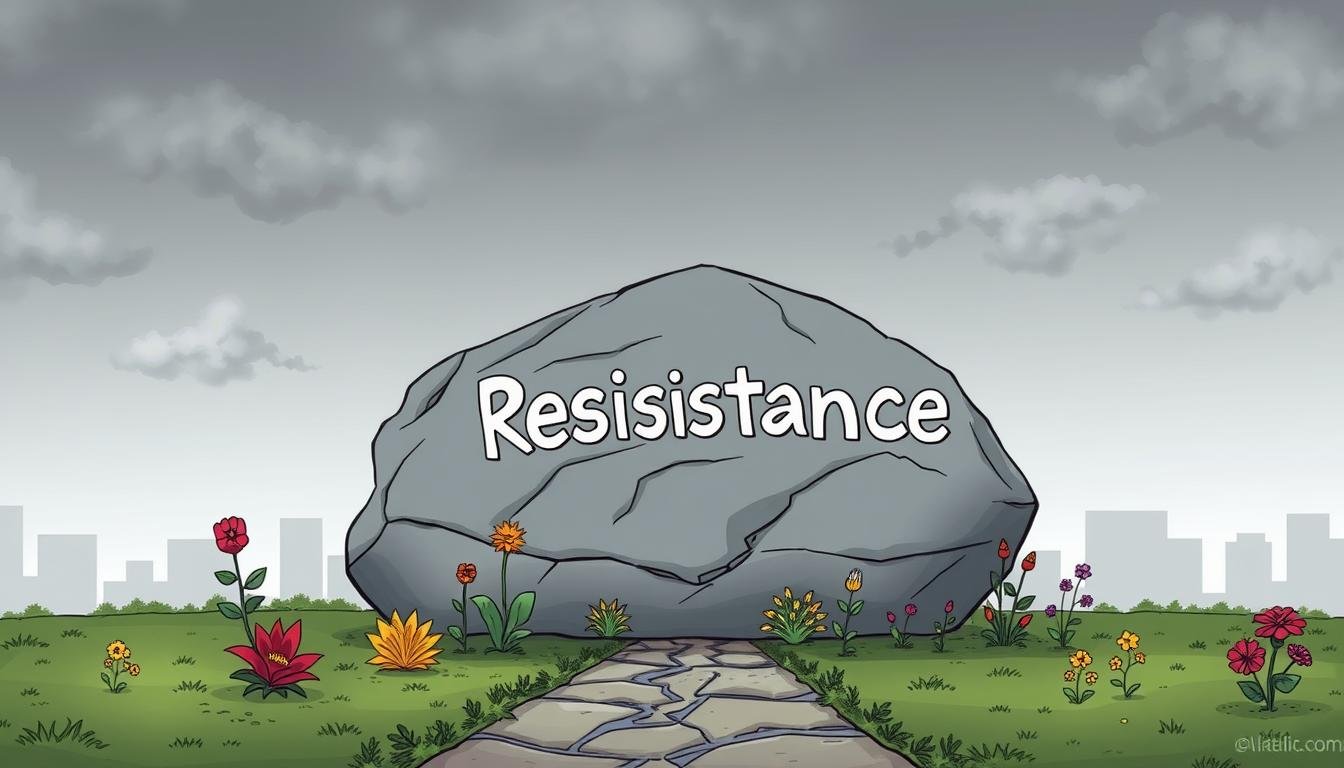Psychological Resistance to Organizational Change
Change is always happening in today’s business world. But, many companies find it hard to make new plans work. Over two-thirds of change efforts fail, often because of employee resistance.
Resistance to change (RTC) is a big problem in managing change. Employees might feel scared and unsure. It’s important to understand these feelings to make changes smoothly.
In the financial world, banks have seen big changes like mergers and new technology. These changes can make employees worry about their jobs and roles. Talking clearly and openly can help calm these fears and build trust.
Studies show that what employees believe and feel affects their readiness for change. Fairness is also key. When people feel treated fairly, they’re more open to new ideas. Leaders who support their teams help make change easier to accept.
Key Takeaways
- Most change initiatives fail due to employee resistance
- Fear and uncertainty drive negative attitudes toward change
- Fair treatment and clear communication reduce resistance
- Strong leadership support is vital for successful change
- Employee trust and engagement are key to overcoming resistance
Understanding the Nature of Organizational Change
In today’s fast-paced business world, change is constant. Companies must adapt to survive and thrive. The need for change comes from market shifts, new technologies, and global competition.
Modern Business Environment and Change Necessity
Change is a must for businesses. Many change initiatives face resistance from employees. Studies show that a high percentage of organizational change efforts end in failure.
This highlights the importance of understanding and managing change effectively.
Impact on Organizational Culture
Organizational culture is key in change management. When changes align with company values, they’re more likely to succeed. However, transformational changes can disrupt routines and affect employee well-being.
A study in Frontiers in Psychology found that such changes often lead to increased stress levels among staff.
Types of Organizational Changes
Organizations undergo various types of change. These include:
- Structural changes (mergers, acquisitions)
- Technological adoptions
- Process improvements
- Cultural shifts
Each type of change requires a unique approach. For instance, technological changes might need more training. Cultural shifts demand strong leadership and clear communication.
“Clear communication reduces change-related uncertainty and anxiety among employees.” – Li et al. (2022)
Understanding these aspects of organizational change is crucial for successful implementation. It helps leaders navigate the complex landscape of business transformation. This minimizes resistance and maximizes positive outcomes.
Psychological Resistance to Organizational Change
Change is always happening in business, but people still resist it. It’s key to know why this happens to manage change well. Studies show eight main reasons for resistance, like fear or feeling threatened.
But, people don’t mind change if it helps them. A study found that winning a million dollars can make people more open to change. This shows how telling employees about the good things in change matters.
To tackle resistance, companies can try different things:
- Open talks to clear up fears and doubts
- Showing empathy and support during change
- Being flexible to meet everyone’s needs
Using psychology and change theories at work can help people accept change better. For example, FasterCapital offers help with market analysis and more. This kind of support can make change feel less scary.
“Change is hard because people overestimate the value of what they have and underestimate the value of what they may gain by giving that up.”
Understanding and tackling the reasons behind resistance can lead to better change management. This way, companies can make their workplaces more flexible and strong.
The Role of Human Psychology in Change Management
Change psychology is vital for organizational changes. It’s important to understand what makes employees anxious or concerned about their identity. Studies show that 40% of employees feel anxious about change. This highlights the need for leaders to tackle these psychological barriers.
Fear of the Unknown
Uncertainty can make employees anxious. This fear might lead to resistance to new processes or systems. Leaders should offer clear information and support to ease these worries.
Loss of Control and Security
Change can make employees feel powerless. Research shows that losses affect people twice as much as gains. This is why employees might stick to what they know, even if new methods are better.
Threat to Personal Identity
Changes can challenge an employee’s sense of self. When roles or responsibilities change, some might worry about losing their expertise or status. This fear can cause deep resistance.
| Change Response Category | Percentage of Workforce | Characteristics |
|---|---|---|
| Innovators | 2.5% | Embrace change, seek new experiences |
| Early Adopters | 13.5% | Quick to adapt, influence others |
| Early Majority | 34% | Cautious but open to change |
| Late Majority | 34% | Skeptical, adopt only when necessary |
| Laggards | 16% | Resistant, prefer traditional methods |
Understanding these psychological factors is key to effective change strategies. By addressing employee fears and identity concerns, organizations can create a more welcoming environment for change.
Employee Attitudes and Behavioral Responses
How employees act and feel about change is key to success in any organizational change. For over 60 years, research has shown that how people react to change matters a lot. Sadly, 70% of changes fail, and it’s often because of how people respond.
Support from the organization is very important in how employees react to change. A study with 292 people found that stress at work affects how they feel about change. When employees are stressed, they tend to be less committed and less willing to change.
Good relationships at work are crucial for change success. This shows how important it is to have positive connections in the workplace. Fairness in how things are done also matters a lot. When things are done fairly, people are more likely to accept and support change.
| Factor | Impact on Change Attitudes |
|---|---|
| Perceived Organizational Support | Direct positive relationship |
| Procedural Justice | Higher acceptance and commitment |
| Poor Work Relationships | Significant negative impact |
| Fear of Change Consequences | Increased resistance |
To make changes work better, companies need to reduce stress, improve support, and make sure things are fair. By working on these areas, companies can help employees feel more positive and supportive of change. This makes it easier for organizations to go through big changes successfully.
Key Factors Contributing to Change Resistance
Change is now a constant in our fast-paced world. As technology advances and the economy shifts, companies must keep up. But, many still resist change. Let’s look at what drives this resistance.
Individual Psychological Barriers
Fear is a big reason for change resistance. Employees fear losing their jobs or getting paid less. This fear can make them less productive and absent more often. The uncertainty of change also causes anxiety.
As one expert notes, “Fear is a strong motivator that makes people want to resist change.”
Organizational Cultural Factors
Company culture greatly affects how change is seen. Mid-level managers often resist change the most. This is because they don’t fully understand the change’s purpose or benefits.
Factors like goals not aligning and personal interests can make things harder.
Communication Challenges
Poor communication is a big obstacle to change. Prosci’s research shows that not knowing why change is needed is the main reason for resistance. Clear communication is essential.
Without it, confusion and opposition grow.
To beat these challenges, leaders need to tackle fears, align cultures, and improve how they talk to everyone. This way, they can turn resistance into support and lead successful change.
Leadership’s Role in Managing Resistance
Change leadership is key in guiding organizations through big changes. Leaders need strong skills to handle employee pushback. A study by McKinsey & Company shows that 70% of change efforts fail. This is mainly because of employee resistance and lack of support from management.
Effective leaders show important skills to tackle resistance:
- Authenticity and transparency
- Adaptability to changing situations
- Empathy towards employee worries
- Clear communication of the change plan
- Creating a safe environment
Research by Prosci points out that “active and visible executive sponsorship” is crucial for success. Leaders who show these traits can build trust and a culture ready for change.
“Effective change management can reduce much of the resistance found during organizational changes.”
To manage resistance well, leaders should:
- Deal with the emotional side of change
- Offer the right training and support
- Focus on the real reasons for resistance
- Clearly share the change vision
- Act as role models
By using these methods, leaders can cut down on delays, keep productivity high, and ensure change is adopted.
Communication Strategies for Change Implementation
Effective change communication is key for smooth transitions in organizations. Studies reveal that over 70% of change efforts fail because of poor communication. This shows the importance of clear, open dialogue and feedback.
Transparent Communication Approaches
Being open about change is essential. In the U.S., about one-third of employees don’t get why changes happen. By sharing clear facts and data, companies can show they’re transparent and explain why changes are needed. This can boost employee understanding and involvement by 55%.
Building Trust Through Dialog
Trust is crucial for successful change. Around 85% of employees lose interest in change because they don’t trust the communication. Leaders should:
- Be consistent to build trust up to 40%
- Use visual dashboards to clarify, boosting team alignment by 60%
- Use platforms for real-time collaboration to engage employees by 65%
Feedback Mechanisms
Good feedback systems are key for solving issues and tweaking plans. Only 30% of employees feel heard during changes. Using feedback and surveys can cut resistance by up to 45%. Including employees in the change process can reduce resistance by 50%.
| Communication Strategy | Impact |
|---|---|
| Transparent communication | 55% increase in engagement |
| Consistent messaging | 40% increase in trust |
| Visual dashboards | 60% increase in team alignment |
| Real-time collaboration | 65% increase in engagement |
| Feedback mechanisms | 45% reduction in resistance |
Employee Engagement During Change Process
Change engagement is key for companies going through big changes. Studies show 97% of CEOs have changed how they create value in the last five years. But getting employees involved is hard. A big 73% of companies feel too much pressure from change efforts.
Getting employees on board with change is vital. Gallup found that 50% of engaged employees do well in life. This shows how important it is to include staff in the change process. Using surveys, focus groups, and workshops can help get their views.
This approach not only lowers resistance but also makes employees feel they own the change. The benefits of engaging employees in change are clear. They work better and are less likely to leave.
This is especially important since 90% of companies worry about keeping their staff. By encouraging change participation, companies can ease the doubts of one-third of workers. Recognizing and rewarding those who help with change can make employees more motivated and committed. This creates a workforce that can handle future challenges.
Source Links
- Frontiers | The Psychology of Resistance to Change: The Antidotal Effect of Organizational Justice, Support and Leader-Member Exchange
- The Psychology of Change Management: Understanding and Overcoming Resistance
- Reactions towards organizational change: a systematic literature review
- Transforming Stress into Strength: Navigating Organizational Change with Psychological Insights | and Change
- 8 Reasons Why People Resist Change – Management is a Journey®
- Psychology and Behavior Change in Change Management
- The Psychology Of Resistance To Change – FasterCapital
- Psychology of Change: Building Change-Ready Organizations
- The Psychology of Change Management: Understanding and Overcoming Resistance
- The Psychology Of Change Management – Key Tips For Leaders
- Assessing Employees’ Reactions to Organizational Change
- Attitudes towards organizational change: What is the role of employees’ stress and commitment?
- Understanding Why People Resist Change
- Resistance to Change: 7 Causes & How to Overcome Them (2024)
- Managing Resistance To Change Overview
- Overcoming Resistance To Change: 7 Strategies | Primeast
- Council Post: Three Tips For Managing Resistance To Change
- Change Communication | Strategies to Reduce Resistance
- 7 Strategies for Overcoming Resistance to Change in an Organization
- The Link Between Change Management and Employee Engagement
- Employee Engagement During Organizational Change | Assembly








